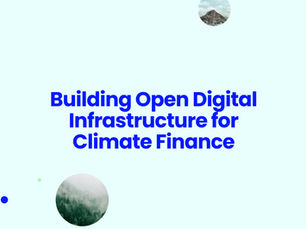
Updated 28.03.2025
Since the Industrial Revolution of the nineteenth century, human activities have led to a significant decline in biodiversity on a global scale. The International Union for Conservation of Nature estimates that 42,100 species are currently threatened with extinction, largely as a result of:
Habitat loss and fragmentation are accelerated by urbanization, infrastructure development, resource extraction, and similar activities.
Increased greenhouse gas (GHG) emissions cause rising temperatures, which not all species can adapt to quickly enough. This destroys vital habitats such as coral reefs and polar ice caps.
Pollution and chemical contamination can disrupt ecosystems and cause long-term habitat damage, significantly harming aquatic organisms.
The three pillars of biodiversity—species, genetic, and ecosystem diversity—are crucial in maintaining ecosystems' overall stability. An ecosystem with a high level of biodiversity is more resilient to environmental changes and enables its inhabitants to adapt to and recover from disruptions more quickly.
The International Day for Biological Diversity, which takes place on May 22nd each year, encourages people to recognize that functioning ecosystems and strong biodiversity are vital to all species living within them, including humans. Notably, a diverse ecosystem is robust and can withstand environmental challenges such as natural disasters and the proliferation of invasive species. With biodiversity in decline, however, we face challenges for the 42,100 species above and for all human and non-human life.
The benefits of strong biodiversity
The Kunming-Montreal Global Biodiversity Framework—an outcome of the 2022 United Nations Biodiversity Conference and often termed the ‘Paris Agreement for Nature’—now gives humanity a framework to recognize the fundamental importance of biodiversity. Biodiverse ecosystems provide services that might be largely intangible but critical to our survival and well-being. These include:
the purification of water and air;
the formation of soil (which is an effective and cheap capturer of carbon);
automated regulation of diseases and pests; and
the provision of raw materials.

Additionally, as we have a natural connection to our environment, a loss in biodiversity can also lead to a loss of ties to our world, leading to cultural and aesthetic deficits.
Restoring biodiversity is an ongoing challenge. Governments, organizations, and individuals work on addressing this subtopic of climate change—but given that time is of the essence, functioning solutions available right now must play a key role in reversing the damage already done. One such solution is the Voluntary Carbon Market.
The role of carbon credits in biodiversity
Carbon credits are traditionally used to offset GHG emissions caused by human activities to close the emissions gap. However, carbon credits can also positively affect biological diversity—sometimes directly, sometimes indirectly—through the activities of the associated carbon projects. For example:
Reforestation projects restore previously destroyed habitats (or create entirely new ones). They also sequester carbon, which lowers global temperatures over time.
Renewable energy projects can replace energy generated by burning fossil fuels, reducing air and water pollution and thus enabling various species to return to once-destroyed habitats.
Of course, not all carbon credits are intended to directly unlock benefits to biodiversity. To ensure that credit can be used as a trusted means of maintaining or boosting biodiversity, reliable frameworks like REDD+ by the UNFCCC COP have been established.
REDD+ seeks to reduce emissions resulting from deforestation and forest degradation. By preserving forests, habitats are protected, and ecosystem services are maintained. This can lead to positive impacts on biodiversity in the areas where REDD+ projects are situated and a multitude of co-benefits.
According to the recent open letter by Indigenous peoples supporting REDD+ states, Indigenous and community lands hold at least 22% of the carbon stored in tropical and subtropical forests, 17% of the total carbon stored in forests, and 80% of the world’s biodiversity. Suppose we are to halt deforestation and keep global warming to 1.5°C by achieving a net-zero world. In that case, high-integrity climate finance must be scaled and channeled to Indigenous-led conservation efforts that preserve biodiversity as a foundational aim.
As long as the project delivers its vision, then organizations and individuals choosing to support verified REDD+ projects can expect to support growth in biodiversity as well. In the Digital Carbon Market, such projects are well represented in the NBO, MCO2, and NCT pools. Examples include:
The Pacajai REDD+ Project in Brazil was created to stop the deforestation of more than 130,000 ha of forest.
The North Pikounda Project is designed to protect over 90,000 ha of unlogged, native Congolese forest from deforestation.
These and many more similar projects are available on Carbonmark right now, and you can easily filter for Forestry projects if you are looking for this type of carbon credit.
The many different types, regions, and vintages also enable companies to support local communities, as organizations can choose which carbon project to support—whether on the other side of the world or in their proverbial backyard.
Blue carbon credits on Carbonmark
Beyond large-scale UN initiatives such as REDD+, some carbon projects specifically focus on improving biodiversity in specific ecosystems. One great example of carbon credits with potentially large benefits to ecosystems and biodiversity is blue carbon credits. This type of credit focuses on conserving and restoring coastal and marine ecosystems, ranging from salt marshes to seagrass beds and mangroves. Through its partnership with Vlinder, Mangrove DAO recently made this type of credit available on Carbonmark.
This specific project aims to restore roughly 2,260 hectares of degraded lands in Myanmar, ultimately aiming to create a healthy mangrove ecosystem. This benefits biodiversity in this area while offering co-benefits such as poverty reduction by creating sustainable livelihoods in coastal communities. Indeed, such blue carbon credits can offer multiple benefits to their ecosystems:
Numerous marine species feed, breed, and live in these areas. Restoring habitats increases biodiversity across many different species, including fish and shellfish, birds, and other wildlife indigenous to mangroves.
Mangroves are a natural barrier against natural disasters, providing shelter for marine organisms. Seagrass improves water quality and helps maintain the local food chain.
Marine ecosystems also have high carbon storage potential, which allows them to capture and store substantial amounts of carbon in their sediment. This can indirectly positively affect biodiversity on a global scale.

This practical example highlights the benefits enabled by carbon credits that are available right now. Selling them on an open market allows this project to continue its work and protect the area against further degradation, thereby substantially boosting biodiversity via a virtuous circle effect.
Linking your success to carbon credits
Historically, humans have not successfully assigned value to ecosystems and their associated biological diversity. Unless they generate a financial return—such as through tourism activity or agricultural use—ecosystems and the diverse groups of species living within them, have not been thought of as financially relevant despite their unquestionable value to our entire planet.
Carbon credits, when created following strict, reliable standards, link a value not only to carbon removal or reduction but also to biodiversity and, thereby, ecosystems as a whole. They can play a vital role in conservation efforts, even if not all types of carbon credits directly address this goal.
Beyond the conservation and restoration of biodiverse ecosystems, companies that do engage in carbon offsetting activity through the use of carbon credits also benefit in immediately tangible ways, such as:
more decisive reductions of their emissions compared to companies not using carbon credits;
a faster path to Net Zero enabled by the creation of consistent ESG goals and
the potential to generate higher returns compared to companies that do not act in an environmentally responsible way.
The International Day for Biological Diversity is an opportunity to familiarize yourself with the positive effects of carbon credits on biodiversity and how the portfolio of more than 20 million carbon credits on Carbonmark can help your organization reduce its GHG emissions.
If you are interested in buying carbon credits and helping your organization reach its ESG goals, visit our Buyers page and explore our offer.






